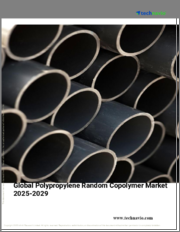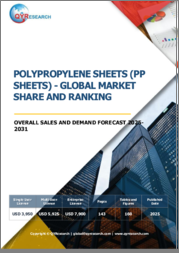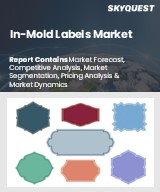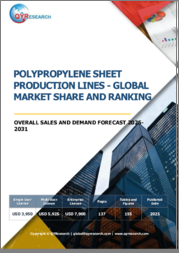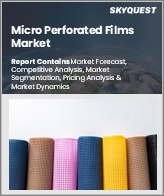
|
시장보고서
상품코드
1307998
세계의 폴리프로필렌 시장 : 수요, 생산능력, 유형, 산업, 용도, 지역별, 지역별 - 시장 규모, 예측, 코로나19의 영향 분석 및 예측(-2028년)Global Polypropylene Market: Analysis By Demand, By Production Capacity, By Type, By Industry, By Application, By Region, Size & Forecast with Impact Analysis of COVID-19 and Forecast up to 2028 |
||||||
세계의 폴리프로필렌 시장 규모는 2022년 1,167억 9,000만 달러에서 2028년 1,596억 6,000만 달러에 달하고, 2023년부터 2028년까지 예측 기간 동안 5.35%의 CAGR을 나타낼 것으로 예상됩니다. 포장재에 대한 수요 증가, 자동차 분야에서 폴리프로필렌의 사용 증가는 시장 성장을 가속하고 있습니다.
이 보고서는 세계의 폴리프로필렌(Polypropylene) 시장을 조사했으며, 시장 개요, 시장 분석, 기업 프로파일 등의 종합적인 정보를 제공합니다.
목차
제1장 주요 요약
제2장 서론
- 폴리프로필렌 : 개요
- 폴리프로필렌 세분화 : 개요
- 폴리프로필렌 세분화
제3장 세계 시장 분석
- 세계의 폴리프로필렌 시장 : 분석
- 세계의 폴리프로필렌 시장 : 개요
- 세계의 폴리프로필렌 시장 : 매출별
- 세계의 폴리프로필렌 시장 : 유형별(호모폴리머 폴리프로필렌, 코폴리머 폴리프로필렌)
- 세계의 폴리프로필렌 시장 : 산업별(포장, 자동차, 인프라 및 건설, 소비재 및 라이프스타일, 전기 및 전자, 자동차, 의료 및 의약품, 기타)
- 세계의 폴리프로필렌 시장 : 지역별(아시아태평양, 유럽, 북미, 세계 기타 지역)
- 세계의 폴리프로필렌 시장 : 유형 분석
- 세계의 폴리프로필렌 시장 : 개요 : 유형별
- 세계의 호모폴리머 폴리프로필렌 시장 : 매출별
- 세계의 코폴리머 폴리프로필렌 시장 : 매출별
- 세계의 폴리프로필렌 시장 : 산업 분석
- 세계의 폴리프로필렌 시장 : 개요 : 산업별
- 세계의 포장용 폴리프로필렌 시장 : 매출별
- 세계의 자동차용 폴리프로필렌 시장 : 매출별
- 세계의 인프라 및 건설용 폴리프로필렌 시장 : 매출별
- 세계의 소비재 및 라이프스타일용 폴리프로필렌 시장 : 매출별
- 세계의 전기 및 전자용 폴리프로필렌 시장 : 매출별
- 세계의 자동차용 폴리프로필렌 시장 : 매출별
- 세계의 의료 및 의약품용 폴리프로필렌 시장 : 매출별
- 세계의 기타 폴리프로필렌 시장 : 매출별
- 세계의 폴리프로필렌 시장 수요 : 분석
- 세계의 폴리프로필렌 시장 : 개요 : 수요별
- 세계의 폴리프로필렌 시장 : 수요별
- 세계의 폴리프로필렌 시장 수요 : 용도별(사출성형, 필름 및 시트, 라피아, 섬유, 블로우 성형, 기타)
- 세계의 폴리프로필렌 시장 수요 : 지역별
- 세계의 폴리프로필렌 시장 수요 : 용도 분석
- 세계의 폴리프로필렌 시장 수요 : 개요 : 용도별
- 세계의 사출성형 폴리프로필렌 시장 : 수요별
- 세계의 필름 및 시트 폴리프로필렌 시장 : 수요별
- 세계의 라피아 폴리프로필렌 시장 : 수요별
- 세계의 섬유 폴리프로필렌 시장 : 수요별
- 세계의 블로우 성형 폴리프로필렌 시장 : 수요별
- 세계의 기타 폴리프로필렌 시장 용도 : 수요별
- 세계의 폴리프로필렌 시장 생산능력 : 분석
- 세계의 폴리프로필렌 시장 : 개요 : 생산능력별
- 세계의 폴리프로필렌 시장 : 생산능력별
- 세계의 폴리프로필렌 시장 생산능력 : 지역별
제4장 지역 시장 분석
- 아시아태평양의 폴리프로필렌 시장 : 분석
- 유럽 폴리프로필렌 시장 : 분석
- 북미 폴리프로필렌 시장 : 분석
- 세계 기타 지역 폴리프로필렌 시장 : 분석
제5장 신형 코로나바이러스(COVID-19)의 영향
- COVID-19의 영향
- COVID-19의 폴리프로필렌 시장에 대한 영향
- COVID-19 이후의 시나리오
제6장 시장 역학
- 성장 촉진요인
- 과제
- 시장 동향
제7장 경쟁 구도
- 세계의 폴리프로필렌 시장 진출기업 : 재무 비교
- 세계의 폴리프로필렌 시장 기업 : 생산능력
제8장 기업 개요
- LyondellBasell Industries
- SABIC
- Repsol Group
- ExxonMobil Corporation
- Mitsubishi Chemical Group Corporation
- INEOS Group Holdings S.A.
- LG Chem Ltd.
- Braskem S.A
- Ensinger GmbH
- China National Petroleum Corp(CNPC
- RTP Company
Polypropylene (PP), a polyolefin film created by polymerizing propylene, is one of the most widely employed plastics globally (behind polypropylene), owing to its many highly advantageous characteristics that make it suitable for a wide range of applications. Since polypropylene is a thermoplastic polymer that melts to a liquid at its melting point, it is elementary to mold. It can be reheated and molded into different shapes without severe material deterioration. The global polypropylene market in 2022 was valued at US$116.79 billion and is foreseen to reach US$159.66 billion by 2028. In 2022, the global polypropylene market witnessed a demand of 86.74 million tons, while the global production capacity reached 97.86 million tons.
The global polypropylene market recorded growth in the past few years due to various reasons such as increasing utilization of polypropylene and its wide scale industry in several industry verticals. Growing demand for packaging material and rising use of polypropylene in automotive sector also boosted the global polypropylene market. The polypropylene market is projected to grow at a CAGR of 5.35%, during the forecast period of 2023-2028.
Market Segmentation Analysis:
By Type: The report splits the global polypropylene market into two different product type: Homopolymer Polypropylene, & Copolymer Polypropylene. Homopolymer polypropylene refers to a polymer composed of propylene units only, resulting in a polymer chain made up of a single type of monomer. It is the most common and widely used form of polypropylene. Homopolymer polypropylene offers excellent stiffness and strength properties, making it suitable for applications that require structural integrity and dimensional stability, such as automotive parts, packaging, and consumer goods.
By Industry: The report divides the global polypropylene market into eight industrial verticals: Packaging, Automotive, Infrastructure & Construction, Consumer Goods/Lifestyle, Electrical & Electronics, Agriculture, Healthcare & Pharmaceuticals and Others. Packaging segment held the maximum share in the global polypropylene market. The growing food and beverages industry and growing concern towards the environment is primarily boosting the demand for polypropylene packaging.
By Application: The global polypropylene market demand can be divided into six segments on the basis of application: Injection Molding, Film & Sheet, Raffia, Fiber, Blow Molding and Other. Film & sheet segment is anticipated to grow at the fastest CAGR during the forecasted period. Polypropylene films and sheets are widely used in packaging applications, including food packaging, labeling, and wrapping. These films and sheets provide excellent clarity, stiffness, and moisture resistance. The growth of the e-commerce industry, the need for sustainable packaging materials, and the demand for flexible packaging solutions are key factors driving the growth of this segment.
By Region: According to this report, the global polypropylene market can be divided into four major regions: Asia Pacific (China, Japan, India, South Korea and Rest of Asia Pacific), North America (The US, Canada and Mexico), Europe (Germany, UK, France, Spain, Italy and Rest of Europe), and Rest of the World. The Asia Pacific dominated the market in 2022, primarily owing to inexpensive and affordable quality of polypropylene to most producers who use polypropylene as a raw material for other plastic products. While China continues to be a prominent region of Asia Pacific's polypropylene market, accounting for the rising trend of online purchase of goods and rapid industrialization leading to a surge in demand for packaging material.
Global Polyethylene Market Dynamics:
Growth Drivers: One of the key drivers of the market's expansion is the upsurge in e-commerce sales. The upsurge in e-commerce sales has emerged as a significant driving factor for the polypropylene market. The rapid growth of online shopping has led to increased demand for packaging materials, and polypropylene has become a preferred choice for e-commerce packaging. Polypropylene offers several advantages that make it ideal for e-commerce applications. It is lightweight, durable, and provides excellent protection to products during transit. Its flexibility allows for the creation of custom shapes and sizes, catering to the diverse range of products sold online. Further, the market is expected to increase due to escalating automobile production, rapid urbanization, upsurge in demand for plastic, increase in demand for packaged food and surge in disposable income.
Challenges: However, some challenges are impeding the growth of the market such as fluctuating crude oil prices and availability of substitutes. Polypropylene is obtained by the polymerization of propylene gas, which is derived from petroleum crude oil. The supply and price of crude oil have been oscillating due to volatile political scenarios in the Middle East, as well as in the other oil-producing countries. The inconsistencies in the pricing of crude oil affect the cost structure of the final product, which can have a negative effect on the growth of the market. The use of crude oil as a raw material in the manufacturing of polypropylene indicates that any changes in price of crude oil would impact demand and price of polypropylene.
Trends: A major trend gaining pace in polypropylene market is technological advancements in production processes. Manufacturers are continuously investing in research and development to improve the efficiency, quality, and flexibility of polypropylene production. One key area of advancement is the development and utilization of metallocene catalysts. Metallocene catalysts offer enhanced control over the polymerization process, resulting in polypropylene with improved properties and more consistent quality. These catalysts enable the production of high-performance grades of polypropylene, tailored to specific applications. More trends in the market are believed to augment the growth of polypropylene market during the forecasted period include surging application of polypropylene in agriculture, growing focus on sustainability, etc.
Impact Analysis of COVID-19 and Way Forward:
The COVID-19 pandemic had a significant impact on the polypropylene market. The widespread global lockdowns and reduced economic activity led to a decline in demand for polypropylene products across various industries such as automotive, packaging, and construction. Supply chain disruptions, logistical challenges, and fluctuating raw material prices further affected the market. As economic activities resume, there has been a rebound in demand for polypropylene across various sectors. Industries such as automotive, construction, and consumer goods picked up pace, driving the demand for polypropylene-based products and applications.
The post-COVID era emphasizes sustainability and environmental consciousness. Polypropylene, being a recyclable material, is well-positioned to benefit from the growing demand for sustainable solutions. Initiatives promoting the circular economy and recycling of plastics are expected to drive the adoption of recycled polypropylene in various applications.
Competitive Landscape and Recent Developments:
The polypropylene market is fragmented with the presence of large number of players operating worldwide. Strategic partnerships, capacity expansions, and new polymer type developments are popular strategies adopted by a majority of the players operating in the global polypropylene industry. Recently, researchers at the University of Tokyo have developed a material called isotactic polar polypropylene (iPPP), which in comparison to traditional polypropylene has high isotacticity.
Key players of the polypropylene market are:
LyondellBasell Industries
SABIC
Repsol Group
ExxonMobil Corporation
Mitsubishi Chemical Group Corporation
INEOS Group Holdings S.A.
LG Chem Ltd.
Braskem S.A
Ensinger GmbH
China National Petroleum Corp (CNPC)
RTP Company
In December 2020, LyondellBasell launched Beon3D, an innovative PP product range that provides unique design and allow the production of high-quality, complex 3D printed objects within one step. This product was produced by combining polymer technologies and additive manufacturing. This product range serves transportation, industrial, building & construction, and consumer goods markets.
Table of Contents
- 2.1 Polypropylene: An Overview
- 2.2 Polypropylene Segmentation: An Overview
- 2.2.1 Polypropylene Segmentation
- 3.1 Global Polypropylene Market: An Analysis
- 3.1.1 Global Polypropylene Market: An Overview
- 3.1.2 Global Polypropylene Market by Value
- 3.1.3 Global Polypropylene Market by Type (Homopolymer Polypropylene, and Copolymer Polypropylene)
- 3.1.4 Global Polypropylene Market by Industry (Packaging, Automotive, Infrastructure & Construction, Consumer Goods/Lifestyle, Electrical & Electronics, Automotive, Healthcare & Pharmaceuticals and Others)
- 3.1.5 Global Polypropylene Market by Region (Asia Pacific, Europe, North America and Rest of the World)
- 3.2 Global Polypropylene Market: Type Analysis
- 3.2.1 Global Polypropylene Market by Type: An Overview
- 3.2.2 Global Homopolymer Polypropylene Market by Value
- 3.2.3 Global Copolymer Polypropylene Market by Value
- 3.3 Global Polypropylene Market: Industry Analysis
- 3.3.1 Global Polypropylene Market by Industry: An Overview
- 3.3.2 Global Packaging Polypropylene Market by Value
- 3.3.3 Global Automotive Polypropylene Market by Value
- 3.3.4 Global Infrastructure & Construction Polypropylene Market by Value
- 3.3.5 Global Consumer Goods/Lifestyle Polypropylene Market by Value
- 3.3.6 Global Electrical & Electronics Polypropylene Market by Value
- 3.3.7 Global Agriculture Polypropylene Market by Value
- 3.3.8 Global Healthcare & Pharmaceuticals Polypropylene Market by Value
- 3.3.9 Global Others Polypropylene Market by Value
- 3.4 Global Polypropylene Market Demand: An Analysis
- 3.4.1 Global Polypropylene Market by Demand: An Overview
- 3.4.2 Global Polypropylene Market by Demand
- 3.4.3 Global Polypropylene Market Demand by Application (Injection Molding, Film & Sheet, Raffia, Fiber, Blow Molding and Other)
- 3.4.4 Global Polypropylene Market Demand by Region
- 3.5 Global Polypropylene Market Demand: Application Analysis
- 3.5.1 Global Polypropylene Market Demand by Application: An Overview
- 3.5.2 Global Injection Molding Polypropylene Market by Demand
- 3.5.3 Global Film & Sheet Polypropylene Market by Demand
- 3.5.4 Global Raffia Polypropylene Market by Demand
- 3.5.5 Global Fiber Polypropylene Market by Demand
- 3.5.6 Global Blow Molding Polypropylene Market by Demand
- 3.5.7 Global Other Polypropylene Market Applications by Demand
- 3.6 Global Polypropylene Market Production Capacity: An Analysis
- 3.6.1 Global Polypropylene Market by Production Capacity: An Overview
- 3.6.2 Global Polypropylene Market by Production Capacity
- 3.6.3 Global Polypropylene Market Production Capacity by Region
- 4.1 Asia Pacific Polypropylene Market: An Analysis
- 4.1.1 Asia Pacific Polypropylene Market: An Overview
- 4.1.2 Asia Pacific Polypropylene Market by Value
- 4.1.3 Asia Pacific Polypropylene Market by Demand
- 4.1.4 Asia Pacific Polypropylene Market by Production Capacity
- 4.1.5 Asia Pacific Polypropylene Market by Region (China, Japan, India, South Korea and Rest of Asia Pacific)
- 4.1.6 China Polypropylene Market by Value
- 4.1.7 India Polypropylene Market by Value
- 4.1.8 Japan Polypropylene Market by Value
- 4.1.9 South Korea Polypropylene Market by Value
- 4.1.10 Rest of Asia Pacific Polypropylene Market by Value
- 4.2 Europe Polypropylene Market: An Analysis
- 4.2.1 Europe Polypropylene Market: An Overview
- 4.2.2 Europe Polypropylene Market by Value
- 4.2.3 Europe Polypropylene Market by Demand
- 4.2.4 Europe Polypropylene Market by Production Capacity
- 4.2.5 Europe Polypropylene Market by Region (Germany, UK, France, Italy, Spain and Rest of Europe)
- 4.2.6 Germany Polypropylene Market by Value
- 4.2.7 UK Polypropylene Market by Value
- 4.2.8 France Polypropylene Market by Value
- 4.2.9 Italy Polypropylene Market by Value
- 4.2.10 Spain Polypropylene Market by Value
- 4.2.11 Rest of Europe Polypropylene Market by Value
- 4.3 North America Polypropylene Market: An Analysis
- 4.3.1 North America Polypropylene Market: An Overview
- 4.3.2 North America Polypropylene Market by Value
- 4.3.3 North America Polypropylene Market by Demand
- 4.3.4 North America Polypropylene Market by Production Capacity
- 4.3.5 North America Polypropylene Market by Region (The US, Canada and Mexico)
- 4.3.6 The US Polypropylene Market by Value
- 4.3.7 Canada Polypropylene Market by Value
- 4.3.8 Mexico Polypropylene Market by Value
- 4.4 Rest of the World Polypropylene Market: An Analysis
- 4.4.1 Rest of the World Polypropylene Market: An Overview
- 4.4.2 Rest of the World Polypropylene Market by Value
- 4.4.3 Rest of the World Polypropylene Market by Demand
- 4.4.4 Rest of the World Polypropylene Market by Production Capacity
- 5.1 Impact of COVID-19
- 5.1.1 Impact of COVID-19 on Polypropylene Market
- 5.1.2 Post COVID Scenario
- 6.1 Growth Drivers
- 6.1.1 Upsurge in E-Commerce Sales
- 6.1.2 Escalating Automobile Production
- 6.1.3 Rapid Urbanization
- 6.1.4 Upsurge in Demand for Plastic
- 6.1.5 Increase in Demand for Packaged Food
- 6.1.6 Surge in Disposable Income
- 6.2 Challenges
- 6.2.1 Fluctuating Crude Oil Prices
- 6.2.2 Availability of Substitutes
- 6.3 Market Trends
- 6.3.1 Surging Application of Polypropylene in Agriculture
- 6.3.2 Growing Focus on Sustainability
- 6.3.3 Technological Advancements in Production Processes
- 7.1 Global Polypropylene Market Players: Financial Comparison
- 7.2 Global Polypropylene Market Players: Production Capacity
- 8.1 LyondellBasell Industries
- 8.1.1 Business Overview
- 8.1.2 Operating Segments
- 8.1.3 Business Strategy
- 8.2 SABIC
- 8.2.1 Business Overview
- 8.2.2 Operating Segments
- 8.2.3 Business Strategy
- 8.3 Repsol Group
- 8.3.1 Business Overview
- 8.3.2 Operating Segments
- 8.3.3 Business Strategy
- 8.4 ExxonMobil Corporation
- 8.4.1 Business Overview
- 8.4.2 Operating Segments
- 8.4.3 Business Strategy
- 8.5 Mitsubishi Chemical Group Corporation
- 8.5.1 Business Overview
- 8.5.2 Operating Segments
- 8.5.3 Business Strategy
- 8.6 INEOS Group Holdings S.A.
- 8.6.1 Business Overview
- 8.6.2 Operating Segments
- 8.6.3 Business Strategy
- 8.7 LG Chem Ltd.
- 8.7.1 Business Overview
- 8.7.2 Operating Segments
- 8.7.3 Business Strategies
- 8.8 Braskem S.A
- 8.8.1 Business Overview
- 8.8.2 Operating Segments
- 8.8.3 Business Strategy
- 8.9 Ensinger GmbH
- 8.9.1 Business Overview
- 8.9.2 Business Strategy
- 8.10 China National Petroleum Corp (CNPC)
- 8.10.1 Business Overview
- 8.10.2 Business Strategy
- 8.11 RTP Company
- 8.11.1 Business Overview








